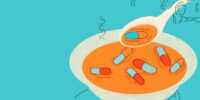A child is often more likely to develop type 1 diabetes if their parent or sibling also has the condition, says Dr. Nwosu. Having extended family members—an aunt or grandparent, for example—with type 1 diabetes can heighten that risk, though not as much as it does when a biological parent has it.7 But here’s where things get thorny, gene-wise—85% of type 1 diabetes diagnoses don’t have a family tie, and only about 10 to 15% of people with a genetic risk actually develop it.8
Environmental factors are also potential causes. These are varied (and often hotly debated in terms of their impact on type 1 diabetes): They can include air pollution, variations in a person’s gut microbiome, and viral infections.8
For years, researchers have linked type 1 with enteroviruses that typically attack the gut, like coxsackievirus and rotavirus. However, any virus that causes the body’s immune system to go haywire and attack the wrong stuff could be a risk factor for type 1 diabetes.9
Newly discovered viruses, like SARS-CoV-2, can be an issue here too. In a large-scale global analysis of children diagnosed with type 1 diabetes during the pandemic, those kids were more likely to have had COVID-19, compared to children who didn’t. (Researchers suspect COVID may trigger autoimmune diseases in people who are already genetically predisposed.10,11
When to get your kid screened for type 1 diabetes
If you’re feeling overwhelmed by the (seemingly endless) list of things that could cause type 1 diabetes, don’t freak out just yet—the disease, even as it increases in prevalence, is relatively rare. In other words, when it comes to protecting your kid’s health, you’re better off teaching them solid hand-scrubbing tips than spending your days worrying about environmental and genetic factors that might largely be out of your control.
Still, if a kid’s sibling or a biological parent has type 1 diabetes, it’s worth getting them screened, ideally between the ages of two and six, per the Juvenile Diabetes Research Foundation (JDRF), the non-profit that funds type 1 research. Otherwise, keep an eye out for the condition’s telltale signs—symptoms like constantly running to the bathroom and eating and drinking way more than normal can come on suddenly, and the disease can easily be mistaken for dehydration, a stomach bug, or another viral infection.







